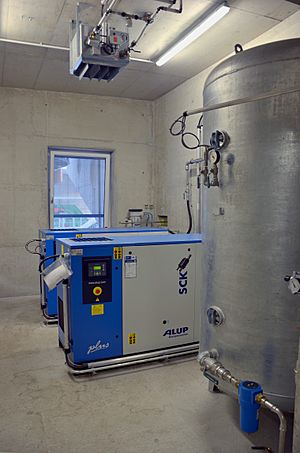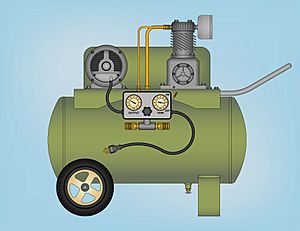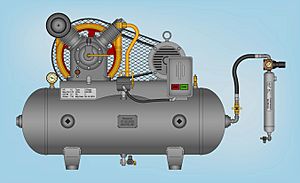Compressed air facts for kids
Compressed air is simply air that has been squeezed into a smaller space, making its pressure higher than the normal air around us. Think of blowing up a balloon; the air inside is under pressure. This high-pressure air can be used for many different jobs.
Contents
How We Use Compressed Air
Compressed air is used a lot in factories and industries. It's almost as important as electricity, natural gas, and water! Even though it costs more to produce than these other utilities, it's very useful.
Here are some ways compressed air is used:
- Pneumatics: This is about using pressurized gases to make things move or work.
- Pneumatic post: Like a vacuum tube system, but using air pressure to send containers with mail or small items through tubes.
- Air tools: Tools like drills, wrenches, or sanders that run on compressed air instead of electricity.
- HVAC control systems: Helping to control heating, ventilation, and air conditioning in buildings.
- Spray painting: Using compressed air to spray paint evenly onto surfaces.
- Vehicle power: Some special vehicles can be powered by compressed air.
- Energy storage: Compressed air can store energy, like a giant battery.
- Fun and games:
- Amusement parks use it for rides.
- Golf courses use it for sprinkler systems.
- Ski resorts use it to make snow.
- Brakes:
- In trains, compressed air helps the brakes work.
- Large trucks and buses also use air brakes.
- Underwater diving: Divers breathe compressed air from tanks. It also helps them inflate special bags to control their buoyancy or lift objects underwater.
- Cooling: A special device called a vortex tube can use compressed air to create cold air.
- Starting engines: Large engines, like those on ships, can be started using a blast of compressed air.
- Shooting things:
- Air guns: These use compressed air to shoot pellets.
- Airsoft and Paintball: These popular games use compressed air to fire plastic pellets or paintballs.
- Cleaning: Great for blowing dust and small bits out of tight spaces.
- Blasting: Using compressed air to blast sand or other materials to clean rust or old paint off surfaces.
- Making plastic items: In Injection molding, compressed air helps shape plastic.
- Airbrushing: Artists and hobbyists use airbrushes with compressed air to paint very fine details.
- Food and drinks: Used in factories for sealing bottles and cans, and in making fermented foods.
- Bottled air: In some places, like Norway, clean compressed air is even bottled and sold!
In Europe, about 10% of all the electricity used by industries goes into making compressed air. That's a lot of energy!
Breathing Compressed Air
When people dive underwater, they breathe air that's stored at very high pressure in tanks. This air is released slowly as they need it. For jobs like surface-supplied diving, air is continuously pumped down to the diver.
The air used for breathing must be very clean. It needs to be free of oil and other harmful things. Even tiny amounts of gases like carbon monoxide, which might not be dangerous at normal air pressure, can become very harmful when breathed under high pressure. Because of this, the machines and filters used to make breathing air are usually separate from those used for tools or other purposes.
Workers building things like bridge foundations sometimes work in special sealed rooms called caissons. These rooms are filled with compressed air to keep water out. Long ago, people knew that working in these pressurized areas could cause problems when workers returned to normal air pressure. This condition is now known as decompression sickness. It happens when tiny bubbles form in the body if the pressure changes too quickly. To prevent this, workers must return to normal pressure very slowly.
Diving deep, beyond about 20 meters (65 feet), can also affect the nervous system. This is called Nitrogen narcosis, and it can make divers feel confused. For very deep dives, special breathing gas mixtures that include helium are often used instead of just air.
How Compressed Air Systems Are Designed
Machines that compress air produce a lot of heat, so the rooms they are in need good ventilation to stay cool.
Removing Water and Oil
When air is compressed, it holds a lot of water vapor. As this compressed air cools down, much of that water vapor turns into liquid water.
To deal with this, systems often cool the air right after it's compressed. This helps remove most of the moisture before the air travels through pipes.
Designers of compressed air systems make sure the pipes are slightly sloped so that water doesn't collect in low spots. They also add drain valves to let trapped water out. The pipes that take air to equipment are often connected from the top of the main air lines. This helps prevent water from flowing into the equipment. The pipes are also sized carefully to make sure air flows smoothly without losing too much energy.
See also
 In Spanish: Aire comprimido para niños
In Spanish: Aire comprimido para niños
- Air compressor
- Cabin pressurization
- Compressed air dryer
- Compressor
- Gas duster
- Rotary-screw compressor




